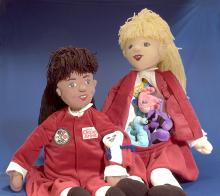Information Possibly Outdated
The information presented on this page was originally released on March 24, 2005. It may not be outdated, but please search our site for more current information. If you plan to quote or reference this information in a publication, please check with the Extension specialist or author before proceeding.
Health project targets Delta school children
MISSISSIPPI STATE -- Obesity is no small problem for Mississippians, and a program under way in the Delta addressing it by promoting healthy lifestyles among the state's youngest residents: school children.
Mississippi State University's Extension Service is partnering with its sister organizations in Louisiana and Arkansas for the program known as Delta HOPE, which stands for Healthy Options for People through Extension. The program is funded by a W.K. Kellogg Foundation grant and involves educational efforts and evaluation in the Delta region by Extension agents from the three states.
"Obesity is easier to prevent than to treat," said Deborah Little, program coordinator for Mississippi. "If we are going to make a difference, we need to reach the children before they develop unhealthy habits."
Little is the curriculum and evaluation manager for the Extension Family and Nutrition Program at MSU. She said the program is an organized effort to help teachers incorporate nutrition and exercise curriculum in the classroom.
"Teachers don't want or need another thing to do in their classrooms, but this curriculum encourages them to incorporate exercise into their regular lessons," Little said. "For example, children may do jumping jacks or march in place while they work on their spelling or math lessons."
The program combines existing curricula called Take 10! and The OrganWise Guys to focus on physical activity and nutrition. By incorporating 10 minutes of exercise three times a week, children receive an extra 30 minutes of exercise they normally would not have received. Additionally, Little said research shows an active curriculum helps students stay on task.
After 26 years of teaching, Gwen Pettis knows what works for kindergarten children, and what does not.
"The activities actually help kids focus. The curriculum reinforces learning skills. We use chants as we move to help us count, recite information and practice beginning sounds," Pettis said. "The children get excited when it's time for Take 10! It's a great way to remind ourselves to exercise. Still, some children get tired after just 10 minutes."
Pettis appreciates anything that encourages physical activity at Batesville Elementary School.
"Currently, we do not have a physical education teacher, and recess is mostly free play," Pettis said. "Students need physical activities in a structured setting."
Pettis receives help from a cast of characters known as The OrganWise Guys. Originally created apart from the Take 10! health curriculum, The OrganWise Guys help teach the basics of human physiology and how the body responds to different foods and lifestyles. They feature 10 characters such as Hardy Heart; Windy, the lungs; and the Kidney Brothers.
Dr. Michelle Lombardo of Duluth, Ga., created the characters and said The OrganWise Guys are ideal for communicating health issues, inciting behavior change and enlivening the education process for any age group. The health material with the OrganWise program targets every age group: ages 3 to 8, first through fifth grades, and adolescents through senior adults.
Lombardo said this concept for teaching children was born out of adult health sessions she led as a health professional in the early 1990s. When adults learned that their health problems were 20 to 30 years in the making, they requested ways to help children make better choices to prevent future trouble.
"We want to help kids take responsibility for their choices and learn why certain choices are good or bad for their health," Lombardo said. "Every child learns the four rules of The OrganWise Guys: low fat, high fiber, lots of water and exercise.
"The Extension agents are essential in promoting this curriculum and making sure that the material is used," she said. "After one teacher in a school begins using the program, it's usually contagious because of how user-friendly the material is and how well it complements the existing objectives."
Contact: Dr. Deborah Little, (662) 325-0623




